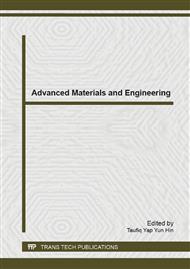p.261
p.265
p.270
p.275
p.280
p.284
p.288
p.292
p.300
The Effect of Air Cold Plasma Treatment on UHMWPE Fiber Surface Modification
Abstract:
This paper adopted the air plasma treatment on ultra-high molecular weight polyethylene fiber surface modification. SEM, tensile test and fiber bundle pull out test were used to characterize the influence of processing time and voltage on the effect of fiber surface modification. The results showed that the optimum conditions of surface modification were obtained by the processing parameters of pressure 15Pa, time 5 minutes and voltage 15V. At this point, the bonding strength was increased by about 82.4%, and the breaking strengthreduced by 9.7%.
Info:
Periodical:
Pages:
280-283
Citation:
Online since:
June 2014
Authors:
Price:
Сopyright:
© 2014 Trans Tech Publications Ltd. All Rights Reserved
Share:
Citation:


